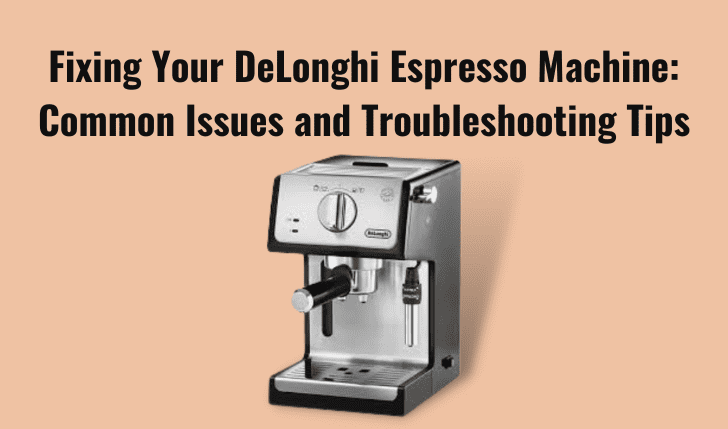[Fixed] 10 Reasons DeLonghi Espresso Machine Leaking
Our site includes affiliate links, which may result in us earning an affiliate commission.
Indeed the Delonghi espresso machine is considered one of the best due to its manufacturing quality. However, you may see your Delonghi espresso machine leaking from the bottom or group head due to frequent use or human error.
Here are 10 quick reasons that can cause Delonghi espresso machine leaking:
- Worn-out or damaged gaskets
- Loose or broken hoses
- Blocked water lines
- Damaged water tank
- Faulty pump
- Incorrectly inserted or damaged filter
- Excessive water pressure
- Cracked or damaged housing
- Poor quality or worn-out components
- Improper cleaning and maintenance
Any of the above reasons can cause leakage in your beloved machine. So, below I mentioned a complete guide on how to fix this problem at home to stop leaking in the machine and get a clean machine while making espresso.
A Step-by-Step Guide How to Fix if Delonghi Espresso Machine Leaking?
Are you a proud owner of a Delonghi espresso machine? If so, then you know how important it is to keep your machine well-maintained and fix any issues. One common issue with these machines is leakage, which various things can cause.

Fortunately, the problem can usually be solved in just easy steps. For those of you who are new to this type of machine, here’s a step-by-step guide on how to fix a leaking Delonghi espresso machine.
Step 1: Locate the source of the leak
The first step is to determine where exactly the leak is coming from. Look for any signs of moisture or dampness around the base or sides of your machine.
If you find any wetness, pay closer attention to that area and check for cracks or worn-out parts that could be causing the leak. Be sure to also look for any loose connections that could be contributing to the problem.
Step 2: Clean out the portafilter and basket.
Once you’ve located the source of the leak, it’s time to start cleaning out your portafilter and basket.
Simply disassemble your portafilter and remove all debris and buildup from inside it using a soft brush or cloth. You should rinse your basket with warm water and let it dry completely before reassembling it onto your portafilter.
Step 3: Inspect all seals and gaskets for wear and tear
After cleaning out your portafilter and basket, take some time to inspect all seals and gaskets for signs of wear or tear. If any parts appear worn or damaged, then they will need to be replaced as soon as possible to prevent further leakage from occurring in the future.
Also Read: Delonghi Espresso Machine Troubleshooting – 7 Problems Fixed
Step 4: Check pressure levels with an espresso gauge reader
Use an espresso gauge reader tool to measure pressure levels inside your machine’s boiler system before attempting any repairs yourself. This will help you ensure everything is working properly before starting work on any replacement parts that may be needed.
Step 5: Replace worn-out parts if necessary
If any parts have been identified as needing replacement during earlier steps, then now is the time to replace them with new ones provided by Delonghi or purchased online from an authorized dealer/supplier.
Follow directions carefully when replacing these parts, as improper installation could result in further damage instead of resolving existing issues.
Step 6: Reassemble all components correctly
Once all necessary repairs have been made (or if no parts needed replacing), it’s time to reassemble all components correctly for your espresso machine. This will help to function properly again without leaking fluids everywhere.
Ensure not to over-tighten any screws during this process, as this could cause further damage down the line due to improper assembly/installation techniques.
10 Reasons Delonghi Espresso Machine Leaking
Nothing ruins a perfect espresso quite like a leaking machine. Before throwing away your beloved De’Longhi espresso machine in frustration, diagnose and solve the issue for a few minutes.

1. Worn-out or Damaged Gaskets
If the gasket that provides a seal between the portafilter and group head is worn-out or damaged, it will allow water to escape during brewing. To fix this issue, you must replace the gasket with one of De’Longhi’s approved replacement parts.
2. Loose or Broken Hoses
If any of the hoses connected to your machine are loose or broken, they can also cause a leak. When inspecting your hoses, pay close attention to their condition.
If they’re degraded or cracked in any way, replace them with one of De’Longhi’s approved replacement parts before continuing use.
Remember to also check for loose connections. If there are any, when you press on them with your finger, tighten them securely with a wrench before operating your espresso machine again.
3. Blocked Water Lines
The water lines connected to your espresso machine may become blocked over time due to mineral deposits from hard water, which can lead to leaking if not addressed properly.
To clean out these lines and remove these deposits, flush out the system by running vinegar through it (using equal parts vinegar and water).
Make sure to run several cycles of pure water after flushing out the system before using it again. This will help ensure that all traces of vinegar have been removed from the lines before brewing with it again.
4. Damaged Water Tank
If you notice water leaking from the side of your espresso machine’s water tank, it could indicate that it has been damaged in some way, either due to regular wear and tear or accidental damage (such as dropping it).
In cases like this, I recommend purchasing a new tank as soon as possible. Avoid using an old tank, as this could lead to further damage down the line.
5. Faulty Pump
A faulty pump can also cause leaks in an espresso machine. If you suspect that yours might be faulty, then our advice would be to contact De’Longhi directly for assistance with replacing it before attempting any repairs yourself (as safety considerations are involved).
6. Incorrectly Inserted or Damaged Filter
An incorrectly inserted or damaged filter is the most common cause of a leaking espresso machine. To check if this is the case with your machine, remove your filter and inspect it for any damage or defects.
If it looks fine, insert it correctly into the portafilter handle and try again. If that doesn’t solve the problem, move on to other potential causes below.
7. Excessive Water Pressure
Another potential cause could be too much water pressure in your machine. To test this theory, remove the water reservoir from your machine. Place it on a flat surface before filling it up with cold tap water until it reaches the “Max” line at the top of the reservoir.
Note that hot tap water can significantly increase pressure levels, so avoid using hot water when filling your reservoir. Once you’ve filled the reservoir with cold tap water, re-attach it to your espresso maker to see if that solves the leak problem.
Also Read: [Solved] 9 Reasons Delonghi Machine Not Pumping Water
8. Cracked or Damaged Housing
This can be caused by wear and tear over time or by dropping or mishandling your Delonghi espresso machine somehow. Check for any cracks or damage around its housing before continuing with other troubleshooting steps.
If you spot any cracks or defects, consider replacing your entire unit. These issues are usually irreparable without extensive experience working with coffee machines.
9. Poor Quality or Worn-out Components
Poor quality components within an espresso maker can also lead to leaks over time as they become worn out from regular use, reducing their effectiveness as time passes.
To prevent this from happening, ensure that all components in your coffee maker are high quality and replace them at least once every 6 months, depending on how frequently they’re used. Additionally, ensure all parts are properly cleaned and maintained regularly according to manufacturer instructions to maximize lifespan.
10. Improper Cleaning & Maintenance
Improper cleaning & maintenance of an espresso maker can also lead to leaks over time. So it’s important to follow manufacturer instructions when cleaning & maintaining yours regularly (e.g., descaling, etc.).
Additionally, ensure that all parts are properly dried after each use before being stored away for later use. Otherwise, moisture buildup can occur, resulting in leaks down the road.
Frequently Asked Questions (FAQs)
Why is my Delonghi Espresso Machine Leaking From Group Head?
How to Fix Delonghi Coffee Machine Leaking Into Drip Tray?
Why is my Delonghi Espresso Machine Steam Wand Leaking?
Conclusion
No matter what kind of problem you might be having with your Delonghi espresso machine, chances are there is a solution that will have you back up and running quickly.
With just a little research and troubleshooting, you can get back to enjoying delicious espressos and lattes made right at home in no time.
As always, if all else fails, don’t hesitate to call professional help. They’ll know exactly what needs to be done to get your beloved espresso maker back up and running again.


![[Solved] 9 Reasons Delonghi Machine Not Pumping Water](https://bestespressocoffee.com/wp-content/uploads/2023/04/Delonghi-Machine-Not-Pumping-Water-768x432.jpg)



